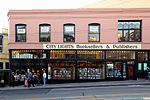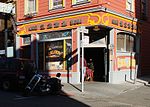Grant Avenue

Grant Avenue in San Francisco, California, is one of the oldest streets in the city's Chinatown district. It runs in a north–south direction starting at Market Street in the heart of downtown and dead-ending past Francisco Street in the North Beach district. It resumes at North Point Street and stretches one block to The Embarcadero and the foot of Pier 39. Grant Avenue is primarily a one-way street; automobile traffic can travel only northbound. In 2012, however, the two blocks of Grant Avenue between Sutter and Geary streets were converted to two-way traffic in order to ease southbound traffic congestion during the multi-year closure of Stockton Street, part of the construction plan for the Central Subway.
Excerpt from the Wikipedia article Grant Avenue (License: CC BY-SA 3.0, Authors, Images).Grant Avenue
Jack Kerouac Alley, San Francisco
Geographical coordinates (GPS) Address Nearby Places Show on map
Geographical coordinates (GPS)
| Latitude | Longitude |
|---|---|
| N 37.7975 ° | E -122.40694444444 ° |
Address
Ali Baba Smoke Shop
Jack Kerouac Alley
94113 San Francisco
California, United States
Open on Google Maps










